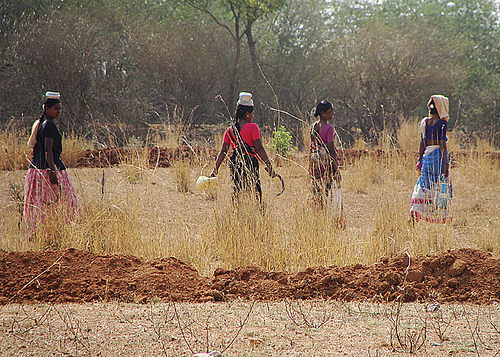Supply response
The supply response is especially important since India is in a catch-up growth phase. Investment is occurring to relieve specific bottlenecks.
Data from India’s Central Statistical Organisation (CSO) shows that fixed investment has remained above pre-crisis levels of 32 per cent of GDP. There is a sharp rise in the production of capital goods. Continuing high investment implies there cannot be a large excess of demand over capacity. Good growth and sales help spread manufacturing costs. If productivity rises, the price-line can be held. A good monsoon after a bad one should see a sharp jump in agricultural production and softening of food prices. Inflation in primary articles will fall from this month onwards because of the base effect and manufactured goods inflation from November.
But wages and commodity prices are pushing up costs. Sustained high food price inflation raises wages, since food is still above 50 per cent of the average consumer basket. That procurement prices have held steady this year, after excessive hikes in the past few years, will provide some relief.
But over the longer term, structural measures, such as better infrastructure and empowering more private initiatives, are required to improve agricultural supply response. That the National Rural Employment Guarantee Scheme (NREGA) has raised rural wages is a good thing, but the emphasis has been on employment and not productivity, although it has the potential to raise both.
A wage rise exceeding that in agricultural productivity raises food prices. Or else rupee appreciation is required to let wages rise without inflation. Prices normally are sticky downwards. So, with monetary accommodation, a relative price change raises the general price level. What goes up doesn’t readily come down except for commodities. But in India administered prices impart an upward bias even for food and fuel.
The petrol price decontrol was required — prices will now be free to fall as well as rise. But the timing of the price rise, when inflation is dangerously high, is unfortunate.
Past oil price hikes have not led to sustained inflation because they either followed or led to severe monetary tightening. The attempt to conserve the macroeconomic stimulus can be consistent with falling inflation only if it enables a supply response.
Post-reform India has had loose fiscal and tight monetary policy. Direct subsidies created hidden indirect costs and raised debt. But inflation harms electoral prospects, so instead of inflating debt away, a severe monetary tightening would be imposed. There would be a large sacrifice of output, but little reduction in chronic cost-driven inflation.
Fiscal consolidation
The government now seems to be trying a better combination: Imposing fiscal consolidation so monetary policy can be more accommodative. Lower debt, deficits and interest rates are useful attributes for a more open economy to have. But rather than raise tax rates that push up prices and costs, a better approach to fiscal consolidation is to reduce wasteful government expenditure. Plugging leakages and cutting allocations in areas where budgets have not been spent would create better incentives to spend.
The government has a poor record in spending effectively. Tax revenues have started rising again with growth, but this boom should not be squandered like the last one. The contribution of economic growth was 55 per cent and of spending cuts was 35 per cent to Canada’s successful deficit reduction in the 1990s.
Monetary policy
A sharp rise in interest rates has severe consequences. We saw the collapse in industry following such a rise in the late 1990s and in July 2008. Policy should rather follow a path of gradual rise in interest rates conditional on inflation. The knowledge of future rise will reduce inflationary expectations, if combined with action to reduce costs.
A short-term nominal exchange rate appreciation reduces costs. This can be very useful to contain a temporary spike in oil or food prices and will become more effective as petrol prices are free and food prices reflect border prices. Today, the price of Washington apples determines that of Indian apples.
The current depreciation runs counter to the attempt to reduce inflation. Changing one exchange rate prevents thousands of nominal price changes that then become sticky and persist, requiring painful prolonged adjustment. Small steps give the freedom to respond to evolving circumstances. But to walk with baby steps one must start early and coordinate action over several fronts.
Ashima Goyal is a professor of economics at the Indira Gandhi Institute of Developmental Research (IGIDR), Mumbai.


One has to realise the effects of inflation and how it can be used as a boon to increase production, lead simpler lifestyles and create newer methods to do what we do better and faster. Supply – Demand and Consumption must play a vital role in how we can maintain and sustain inflation at required levels in moderation.
The Indian inflation is both demand driven and supply constrained that would push up costs. Right now, we do not have a comprehensive study to seggregate these two factors’ influence on Inflation in India. Nor do we have any clear cut mechanism to estimate/guage the inflationary expectations in the country. More driven by external factors of other countries. Though the inflation has been on the rise in the recent months, one should not forget that the middle and upper segments of the society have enough purchasing power as is evident from the rise in the real per capita incomes. What is required is not mindlessly resorting always to raise in the repo and reverse repo rates by the RBI, but rather to provide more credit to the productive sectors at cheap rates and discourage speculative spending. On the supply side, an appropriate distributve policy coupled with regulating the supply of industrial/ crucial inputs is needed. The article is more textual and lacks the ground realities that would help find a solution